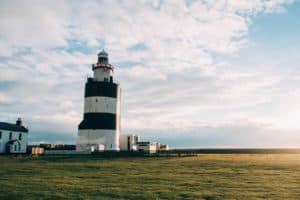Unravel the Caribbean’s 50 Shades of Pink!
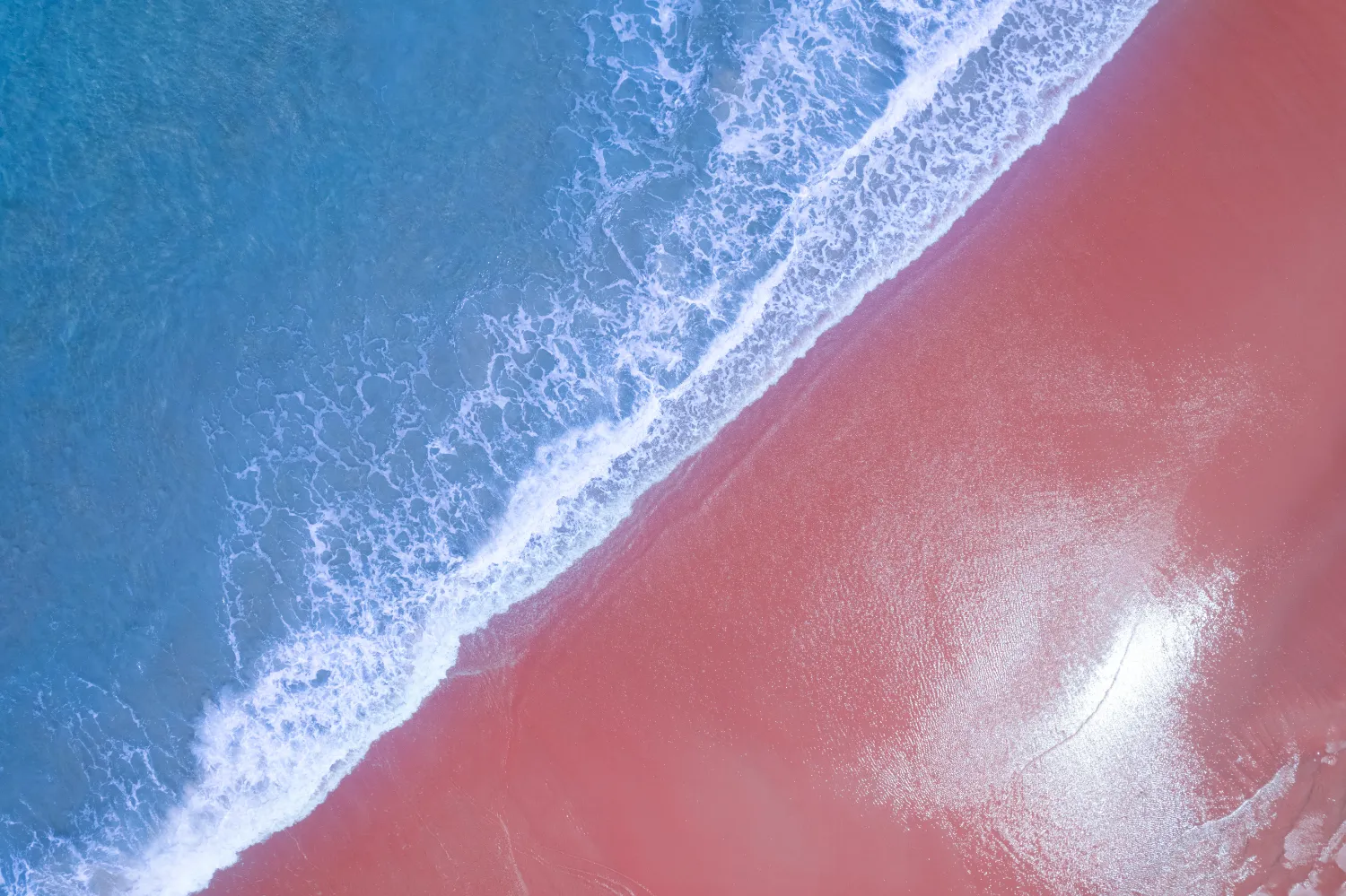
Updated On: November 25, 2023 by Raghda Elsabbagh
Amidst the day’s hustle and bustle, you might catch yourself, even just for a moment, daydreaming about summer. You’re in the Caribbean, lying on a hammock between two palm trees, sinking in the laps of luxury, on golden white sands in front of turquoise waters, sipping on an ice-cold cocktail with a soothing, gentle sea breeze teasing your hair and the sound of waves rolling and crashing – an ambience that’s nothing less than majestic.
But if that’s your definition of majestic, think again! Even though the Caribbean’s white sand beaches are unparalleled worldwide, its little stretches of pink sand beaches are even more exotic. Yes, PINK Sand! When talking about pink, shades can vary from a light rosy tint to a vibrant fuchsia, depending on the surrounding coral ecosystem and the time of the day.
The Caribbean comprises a chain of 13 sovereign island nations: Antigua and Barbuda, Bahamas, Barbados, Cuba, Dominica, Dominican Republic, Grenada, Haiti, Jamaica, Saint Kitts & Nevis, St Lucia, St Vincent & the Grenadines, and Trinidad & Tobago. Bermuda, a British subtropical island territory in the North Atlantic Ocean and the northernmost point of the Bermuda Triangle is sometimes included in these islands.
Now, let us take you on a mentally rejuvenating tour of the most breathtaking pink sand beaches in the Caribbean that will kindle all your senses and add colour to your travel bucket list.
Horseshoe Bay Beach, Bermuda
Bermuda Island has many stunning beaches stretching about 34 km along translucent waters. However, Horseshoe Bay Beach, with its dazzling stone-free salmon-pink sands contrasting with the vibrant teal waters, is the most legendary. It has garnered its name due to its unique curved horseshoe-shaped shoreline enclosed by rocks in curvature.
Horseshoe Bay Beach is part of South Shore Park, a coastal park with an array of beaches running along the southern shore of Bermuda Island. The major beaches in the park are Jobson’s Cove, Horseshoe Bay, Stonehole Bay, Chaplin Bay and Warwick Long Bay, ordered according to their sequence from the west to the east. They’re all linked by a trail running through the dunes behind them.
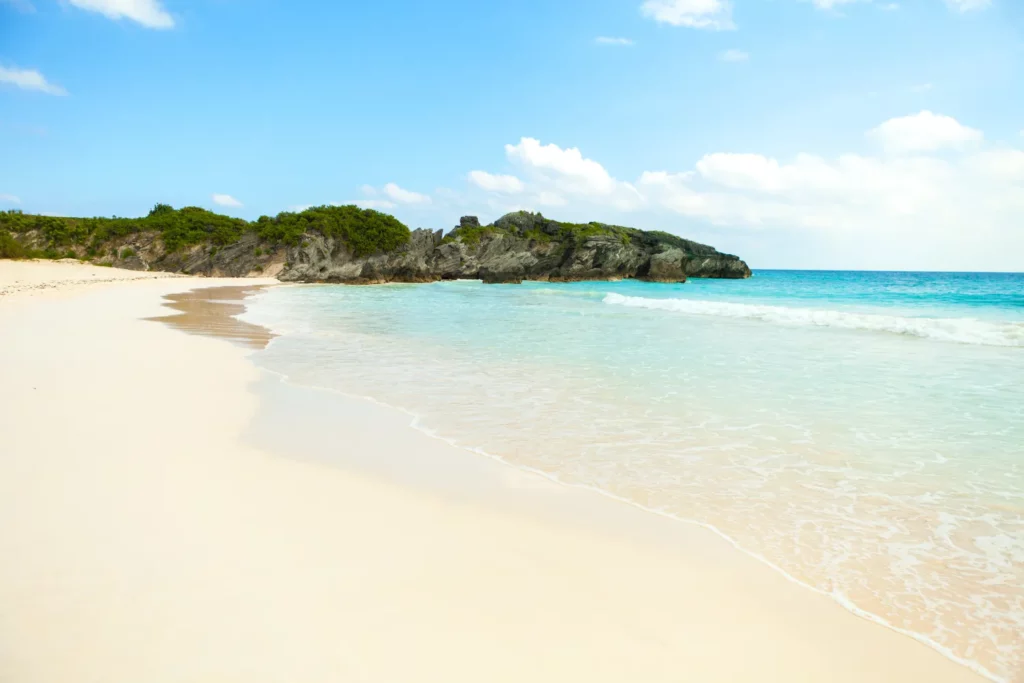
There are two beaches at Horseshoe Bay. The main crescent-shaped one is 0.5 km long, east of the main entrance. To the right lies Port Royal Cove, also known as Baby Beach, and is characterised by its shallow calm waters, suitable for young children. Both beaches are separated by a large rock that thrill-seekers like to climb and leap into the ocean or use as a vantage spot to snap Instagram-worthy pictures of the panoramic views.
Horseshoe Bay Beach is a photographer’s and vacationer’s paradise thanks to its stunning rockscape, fantastic nature views and crystal-clear waters on its blushed sands. The alluring pink sands of Horseshoe Bay Beach never get extremely hot, thanks to the crushed coral and shells, offering you the perfect beach walk. For some adventure, explore some of the nearby caves and secluded coves that will make you feel like a castaway for a little time.
As the day drifts into twilight, you can dine in one of the beach restaurants while dipping your feet in the sand and watching as the sky ignites with a blaze of colours, casting a breathtaking glow upon the beach. As the night unfolds, you can lie on the sand or the edge of a cliff for stargazing and indulge in pure bliss.
Whether you are a sunbather, swimmer, snorkeller, meditator, a family, or a couple seeking a romantic getaway or an unforgettable honeymoon, this beach never fails to bedazzle. Horseshoe Bay Beach gets crowded during peak tourist season, from May to October, especially because these are the usual times when cruise ships dock on Bermuda Island. So, if you’re seeking a serene, more private vacation, try to make it from November to April.
How to get to Horseshoe Bay? Bermuda offers good bus and taxi services that can drop you to the beach in under 30 minutes.
Crane Beach, Barbados
Fancy a first-class ticket to a cotton candy world? Embark on a voyage to Crane Beach in the sun-soaked Barbados. On the island’s south-eastern coast, Crane Beach is famous for its awe-inspiring soft pink sands, contrasting pristine turquoise waves, and dramatic scenic cliffs in the backdrop, making it a picturesque site.
Only one resort, The Crane Resort, sits on the entire stretch of the coastline, perched on top of a cliff, overlooking the beach, allowing an unobstructed panoramic view of the horizons embracing the beach. The Crane Resort is renowned for offering world-class amenities and luxurious accommodations. This makes it an iconic honeymoon destination with its romantic atmosphere and enchanting scenery and colours.
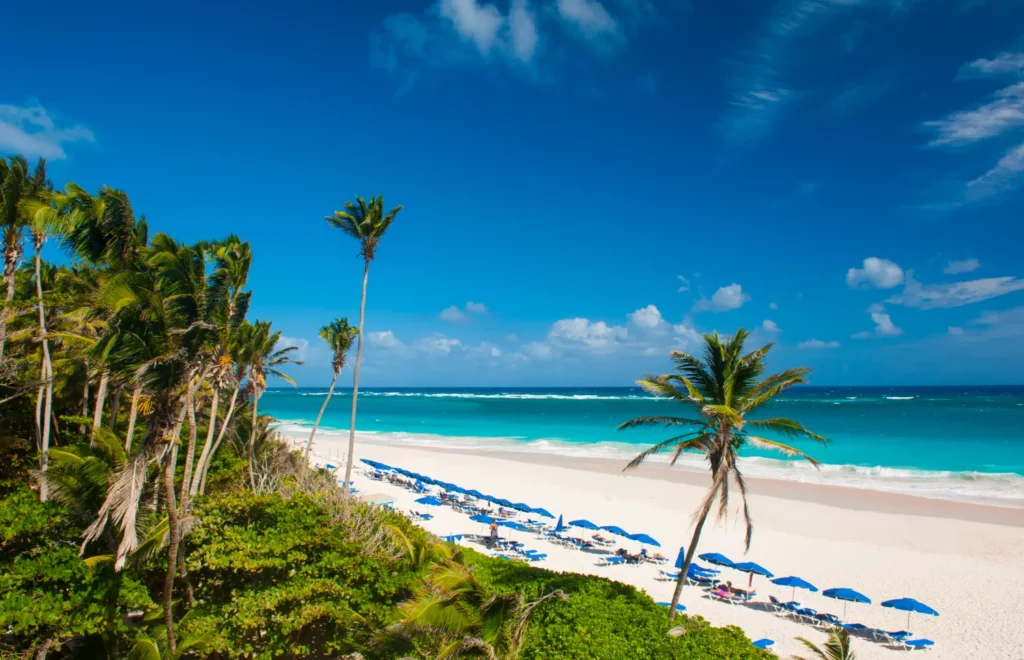
Crane Beach is named after a large crane once used for loading and unloading ships when the coast was a harbour. Today, the beach is a popular destination, luring tourists and travellers to be recognised as one of the ten most beautiful beaches worldwide.
Besides its captivating charm, Crane Beach offers an exhilarating surfing and boogie-boarding experience with its huge waves. While bathing in the pink-hued turquoise waters, venture into some snorkelling and diving activities and get acquainted with the thriving marine life.
How to get to Crane Beach? The beach is a 30-minute drive from Bridgetown, the capital of Barbados. While the beach is public, it can be difficult for non-guests to access it. However, guests of The Crane Resort have the easiest access to the beach.
Pink Sands Beach on Harbour Island, Bahamas
If you’re a fan of royalty, then you should check out Pink Beach on Harbour Island in the Bahamas, the honeymoon destination of Prince William and Kate Middleton. The Bahamas is a cluster of nearly 700 cays and islands in the western Atlantic Ocean, with only about 30 to 40 inhabited islands, one of which is Harbour Island, located 96 km east of Nassau, the capital of the Bahamas.
Located just a few kilometres off the coast of the Bahamian island of Eleuthera, the Pink Sands Beach is a 5 km beach stretch rimmed with some of the most boutique hotels, intimate resorts and ultra-luxurious seaside cottages in the Bahamas.
It is renowned for the high contrast between its shallow turquoise waters, deep azure waters and its rose-tinted sands that make you feel like you’ve stepped into an Instagram filter. However, it’s all REAL; your eyes need time to get used to the indescribable beauty. Its sands are incredibly soft compared to all the pink-sand beaches; you feel you are leaving a trail of footprints on pink talcum powder that tickles your feet and soul. This luminous pink beauty beckons tourists, celebrities, and vacationers from all over the world to indulge in the island’s solitude and enchanting pink hues. No wonder this beach is consistently rated as one of the top five beaches worldwide.
Preservation is key in the small Harbour Island so you won’t find many hotels or resorts. But if you’re lucky enough to book a stay, you’ll have the chance to get pampered by the luxury and the relaxing beauty of the island with its stunning pink-hued sands. Don’t forget to bombard your Instagram followers with splendid shots.

Harbour Island offers much more than just amazing resorts and a pretty beach. Cruising through the maze of cays and islands surrounding Harbour Island is a must-do. If you don’t, you have seen nothing. Head to the Spanish Wells on a day trip, a district in the Bahamas known for its tropical breeze and white powdery sands cuddled by aquamarine cerulean waters. The neighbouring Eleuthera Island is also a 5-minute ferry across sky-blue waters. It is home to the French Leave Beach in Governor’s Harbour, another enchanting pink-sand shoreline.
If you are a diving fanatic, you should also check out one of the world’s best dive sites, the incredible Current Cut Dive. Current Cut is a narrow channel with a very vivacious current where experienced divers drift and tumble for about 10 minutes on average. It is recommended that you wear a wet diving suit to avoid cuts and scrapes from the coral reef. The island also has excellent surf fishing and deep-sea fishing. Stroll between the pastel-coloured charming houses in Harbour Island’s main community, Dunmore Town. It’s a quaint seaside town where everyone knows everyone and where you wake up to the sound of roosters. Its irresistibly slow pace will make you never want to leave.
Enhance your beach experience by visiting Perfect Day at CocoCay, a private island destination exclusively for Royal Caribbean Cruises passengers. This natural sandy island offers all sorts of thrills and chill. Conquer North America’s tallest waterslide, indulge in the luxury of the first Floating Cabana in The Bahamas reminiscent of Bora Bora, and snap some breathtaking photos from a helium balloon 450 feet. Unleash the magic of CocoCay and go home and brag about your experience; you’ve earned this right!
The best time to visit the pink sand beach is from December to April, when the weather is perfect for swimming, sunbathing, and other water activities. So, what are you waiting for? Let your fantasy come true; book your trip to Harbour Island and indulge in the ultimate pink beach vacation!
How to get to Harbour Island? The island is accessible by ferry or boat from nearby islands, Nassau or North Eleuthera airport. It is this seclusion that makes the island such a precious destination.
Pink Sand Beach, Antigua and Barbuda (Low Bay Beach)
Once you step onto the shores of Pink Sand Beach, officially known as Low Bay, in Barbuda, you’ll be transported to a world of enchantment and surreal beauty. Barbuda, one of the Leeward Caribbean Islands, is part of the Antigua and Barbuda nation. Unlike many tourist-heavy destinations, Barbuda has managed to preserve its natural charm untouched with its long stretches of stunning secluded coastlines.
On the far western coast of Barbuda lies one of its signature beaches, the 13-km-long Low Bay beach. It boasts the pinkest sand on all the beaches of the Caribbean. The vibrant pink hues are a result of the abundant coral reefs along the coast and the millions of tiny shells deposited by the waves glistening under the sun. The pink brightness ebbs and flows with the seasons, where the colour deepens the most between October and January.
As the golden sun casts its warm embrace on the powdery pink sands, the entire coastline becomes a breathtaking canvas painted with delicate strokes of coral-coloured dreams. With each gentle stride, you’ll sink into the velvety embrace of the sand, as if nature has crafted a luxurious haven just for you.
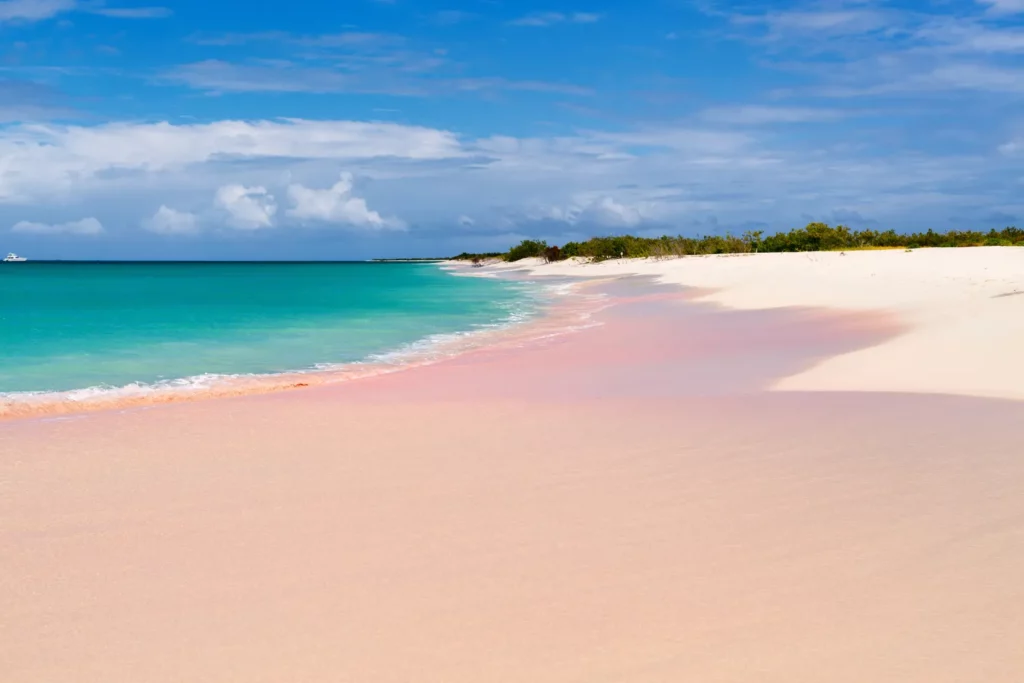
The crystal-clear turquoise waters will lure you into immersing yourself in their tranquil embrace. As you swim, tiny flecks of sunlight dance upon the surface, creating a shimmering symphony of light. Beneath the surface, a vibrant tapestry of marine life unfolds, revealing a kaleidoscope of colours and life. Rays and sea turtles glide gracefully, and schools of tropical fish dart playfully around the vibrant coral reefs. With each passing moment, Pink Beach weaves its spell, capturing your heart and soul in its gentle embrace.
This beach is like a secret whispered among nature, offering a serene escape for solo-souled travellers seeking oceanfront hotels and a tranquil atmosphere away from all the bustling tourist spots. No matter at what time of the year, you’ll almost always get the beach pretty much for yourself with no other soul around. Now, that’s an intimate and romantic getaway for couples on honeymoons.
Apart from its stunning beaches, Barbuda offers other attractions, including the opportunity to tour a frigate bird colony, explore the ruins of Highland House, and visit the Art Cafe, a café, a guest house, and the home of artist Claire Frank. Claire creates paintings of tropical creatures on silk and other crafts. Whether you find solace in a stroll along the shore, indulge in the thrill of water sports, or simply lounge in the sun’s warm caress, Pink Beach is a sanctuary of serenity. This sanctuary promises to weave itself into the fabric of your memories, leaving you forever captivated by its unyielding beauty.
How to get to Low Bay Beach? You can get to Pink Sand Beach in Barbuda from Antigua via ferry services or via small aircraft.
Pink Beach, Bonaire
Embark on a captivating journey from the north to south of Bonaire Island, a Dutch Caribbean gem near the northern shores of Venezuela, traversing through its dynamic landscapes, from untamed rugged cliffs to desert expanses adorned with cacti. Hidden away in the southern region of Bonaire lies the captivating beauty of a dusky rose-hued beach, Pink Beach.
The journey to this secluded, awe-inspiring paradise may be challenging, but the enchanting allure of the dusky pink sands against the backdrop of the azure waters makes it all worthwhile. At Pink Beach, the sun shines perpetually, illuminating a dreamy strip of sand that was reshaped by a storm in 1999. Engrave the essence of this extraordinary experience with a photograph as a testament to the adventure and resilience it took to reach this breathtaking destination.
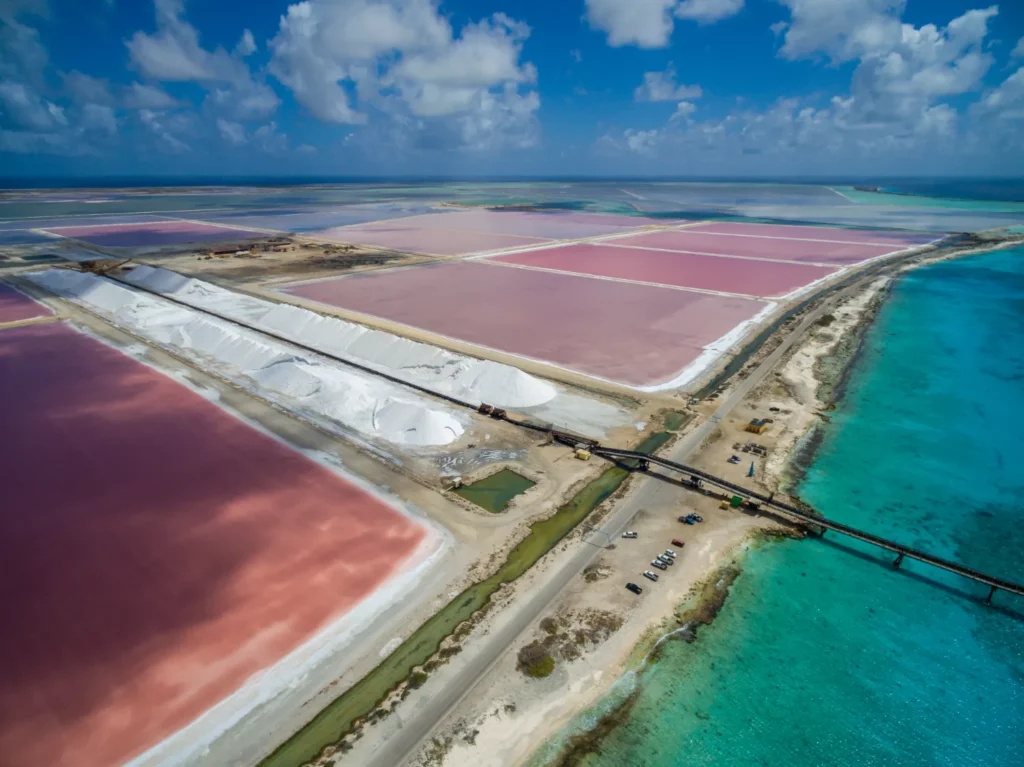
Bonaire has been recognised by the “Caribbean Journal” as one of the top destinations for snorkelling and scuba diving. Travellers flock here to marvel at the famous pink sand and explore the underwater wonderland thriving with vibrant coral reefs and tropical fish diligently protected by Bonaire’s conservation efforts.
How to get to Pink Beach in Bonaire? Transportation services to Pink Beach are limited. You can take a taxi from the Bonaire tourist area and then ask them to return later to pick you up.
There you go; these were only 5 of the best pink sand beaches in the Caribbean to consider for a family vacation or a romantic getaway! Now, all you have to do is to decide on your destination and let the rosy-hued beaches speak volumes of their natural splendour.
The Formation and Composition of Pink Sand Beaches
Pink sand beaches are a rare geological phenomenon. The distinctive rosy hue of the sand comes from the high concentration of coral and shell fragments mixed within it. These fragments must be very finely ground up over time, often to the size of a grain of sand or even smaller. The specific coral species that contribute to pink sands include:
- Elkhorn coral – Branching coral with a pale pink or cream colour. As it deteriorates, it releases pinkish fragments.
- Staghorn coral – Another branching species that is reddish-brown. Provides a pinkish-orange hue to sand.
- Sponge species – Some sponges have a pinkish skeletal structure that can tint sand.
In addition to coral and shell debris, mature pink sand contains a high percentage of calcium carbonate, often above 95%. The calcium carbonate acts as a natural cementing agent that binds the sand into a stable form. Normal sand beaches have much lower calcium carbonate levels, around 15-20%.
The perfect conditions are needed for pink sands to form. The coral and shells must be subjected to just the right amount of wave action to break them down into tiny fragments without pulverizing them completely. A sheltered cove or bay area is ideal. The ocean currents need to sort these fragments and concentrate the pinkish ones together while washing away other debris. Over decades to centuries, the natural wave action, currents, and high calcium carbonate content blend the pink fragments into mature pink sand deposits.
The mineral composition of pink sands can vary slightly based on the specific coral species and shells that contribute to it. But in general, the key elements are:
- Calcium carbonate – 95%
- Magnesium – 2%
- Silicates – 2%
- Shell/coral fragments – 1%
The exceptionally high calcium carbonate concentration gives pink sand a softer, almost powdery feel compared to regular sand. The coral and shell fragments add texture and create a subtle pink colouration.
Additional Pink Sand Beach Locations
While Harbour Island, Barbuda, and Bermuda are the most famous Caribbean destinations with pink beaches, some lesser-known places also have pink sands. These include:
Jumby Bay – An island off the coast of Antigua with over 300 acres of perfect pink sand beaches. The sand gets its hue from the surrounding red coral reefs breaking down.
Caya Lobos – Located in Anguilla, this small uninhabited island is ringed by pink sand beaches on one end. The beaches are peaceful and secluded.
Sandy Island – This tiny resort island off the coast of Grenada has a beautiful pink sand beach formed from eroding coral reefs nearby.
Shell Beach – On the island of St. Kitts, this aptly named beach has light pink sands comprised of fragmented sea shells and coral.
Punta Rucia – A remote fishing village in the Dominican Republic with off-the-beaten-path pink sand beaches that draw tourists.
Akumal Beach – Part of Mexico’s Yucatan Peninsula, Akumal has stretches of powdery, pinkish sands along its coast.
In addition to the Caribbean, some other parts of the world with rare pink sand beaches include the Maldives, Greece, and Australia. However, the Caribbean does contain the highest concentration of these unusual beaches.
Impact of Climate Change on Pink Sand Beaches
The delicate balance required to create pink sand beaches may be disrupted as the oceans warm due to climate change. Coral reefs are highly vulnerable to bleaching and death from increased sea temperatures. As reefs die off, new pink coral fragments will decrease over time.
Ocean acidification from higher CO2 absorption will also take a toll. The shells of creatures like conchs, mussels, and oysters will be prone to dissolving and breaking down faster in acidic water. Shell debris makes up an important part of pink sand makeup.
If climate change impacts reduce coral reef health and shellfish populations in surrounding waters, the future formation of pink sands would be hindered. Existing pink beaches could also begin to degrade or disappear altogether if they are not replenished with new coral and shell fragments.
The Caribbean’s rare and beautiful pink sand beaches provide an iconic tropical experience many travellers dream about. Lounge on the rosy sands of Harbour Island, walk along Barbuda’s sweeping pink coastline or relax in Bermuda’s picturesque coves. For the adventurous, discover off-the-beaten-path pink beaches on islands like Jumby Bay or Caya Lobos.
These delicate pink sand landscapes require the right natural conditions to form over many years. But climate change threatens their future as coral reefs and shellfish populations decline. Protecting the marine ecosystems surrounding the Caribbean will be crucial to preserving these unique pink sand havens.
When you’re ready to plan your pink sand getaway, consider acquiring citizenship in the Caribbean. Programs like St. Kitts and Nevis’ Citizenship by Investment provide visa-free access to the world’s most beautiful tropical destinations. Holding Caribbean citizenship and a Caribbean CBI makes enjoying the pink beaches and laidback lifestyle easy. Don’t just dream of swaying in a hammock on cotton-candy-coloured sands – make it a reality with citizenship by investment.




